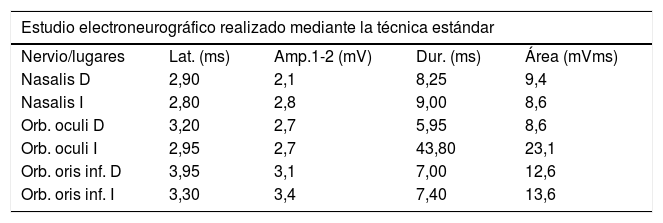La parálisis facial periférica supone un importante impacto físico, psicológico y social para el paciente, y el estudio neurofisiológico cuantifica el grado de lesión del nervio y valora el pronóstico de recuperación funcional. Se expone el caso de una mujer con parálisis facial periférica izquierda de 3 meses de evolución tras un implante dentario, con una funcionalidad facial del 85,5% y con un estudio neurofisiológico normal, realizado según el protocolo estándar, que, al modificar la técnica centrada en el orbicularis oris en su porción superior, muestra una asimetría de amplitud y signos de denervación. La modificación de la técnica estándar según la afectación clínica del paciente permite objetivar un déficit y diferenciarlo de una posible asimetría fisiológica o de una simulación por parte del paciente.
Peripheral facial nerve palsy (PFNP) has a substantial physical, psychological and social impact on patients. Neurophysiological study quantifies the degree of nerve injury and assesses prognosis. We present the case of a woman with a 3-month history of left PFNP after a dental implant, with facial functionality of 85.5% and with a normal neurophysiological study performed according to the standard protocol. By modifying the technique centred on the orbicularis oris in its upper portion, the procedure showed an asymmetry of amplitude and signs of denervation. This allowed us to detect a deficit and differentiate a possible asymmetry or simulation by the patient.









